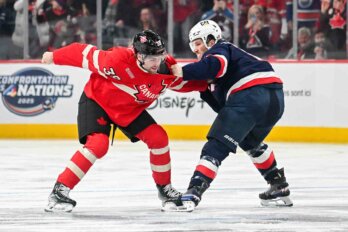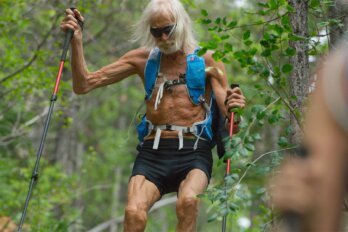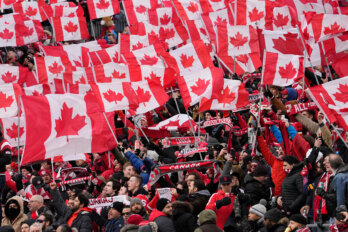The Raptors’ championship parade, in June 2019, was a magical moment for Toronto—the result of uniting behind a worthy cause. A lot has been written and said about the team’s impact beyond the sport of basketball itself. The Raptors’ success gave the Canadian economy some bounce, grew participation rates in sports, and inspired more kids to aim to play at a high level.
As Gamal Abdel-Shehid, an associate professor at York University’s school of kinesiology and health science, notes in a column in The Conversation, the team “cemented themselves into the fabric and psyche of the city.” He goes on to observe that “many of the team’s icons have embodied hard work and beating the odds, but also a dedication to greater causes than basketball. As much as the on-court success, it’s translated into a groundswell of civic pride previously unseen. It is a marvel to watch.” From Masai Ujiri, the president of the team, to its roster during that unforgettable year, the team reflected a lot of what Toronto is: a convergence of ideas and people from all over the globe thriving when they work together.
With that awareness, basketball in the Greater Toronto Area took on a different meaning—and it wasn’t just about professional sports. But, soon after the parade and the cheering ended, that sense of awakening was overtaken by something far less attractive yet still galvanizing.
Luke Galati, a young Toronto filmmaker, is proud to call South Riverdale his neighbourhood. Within this urban home base, near Earl Grey Senior Public School, is a basketball court—a space that may as well have Galati’s name on it. “I went there basically every day—every evening, every weekend, I’d be out there,” he recalls.
To my eye, Galati’s devotion to that hardtop cathedral was like daily Mass. He met his best friends there, and he played with total strangers and neighbours from down the street. “It is really just an amazing place where everyone would just come after school or in the evenings.” Sacred ground.
One day, soon after the Raptors’ championship parade, Galati was shocked to see that the city had taken down the basketball nets despite the groundswell of interest in the sport from kids and adults alike. He knew the nets at many other courts nearby had also been taken down over the years. “It always kind of rubbed me the wrong way,” he says.
The ironies pile up. During the Raptors’ championship parade, Galati was walking by the court and saw a family and some kids hanging out. “They were literally shooting on a backboard that had no rim,” he says. “I just thought that was so wrong.”
Galati’s love of basketball is as strong as his love for his neighbourhood. He played competitively for years: Ontario Basketball Association hoops with East York, high school ball at Riverdale Collegiate, summer camps galore, and Amateur Athletic Union ball with the Northern Kings, which fields kids who live in that part of the city. Galati got onto the Kings’ squad out of sheer chance, he says.
It goes without saying that the game has given him so much. “Growing up, going to my local courts and playing basketball was like the best way to get to know my neighbours,” he recalls. “And it was an amazing way to get to know people who are from my street but also who are down the street, the people who maybe have more money than me, people who have less money than me—it’s kind of like the great equalizer.”
His love of the sport even drove him into sports journalism, which eventually led him to make a documentary about the legendary Eastern Commerce basketball program. His forty-minute film, Eastern, was shot over a year, just before the school closed. Galati describes the film, which won an award for best short documentary at the 2016 Toronto Short Film Festival, as “the little engine that could.” It was eventually screened at the Toronto International Film Festival Bell Lightbox theatre. Galati is proud of how Eastern resonated. But it was his next endeavour that really got attention.
Galati, who had become an associate producer with Maple Leaf Sports and Entertainment and a Raptors staffer, made some inquiries with the Toronto District School Board (TDSB). He learned that, at basketball courts across the city, the nets come down after a certain time of the day. But, in some cases, including the courts at Earl Grey, the board also took down the rims in response to noise complaints from local residents. In light of the Raptors’ victory and the years he’d spent making community connections on those courts, Galati decided to start a petition, in April 2019, to lobby the TDSB to change the policy. The petition—which is still online—painted a pretty stark picture of the circumstances:
The rims (the actual hoops) are removed once school ends at 3 p.m.
The net that was a constant up & broke down after years was never fixed, leaving nowhere to play basketball outside for the community.
This means that after school hours, in the evenings & weekends—kids in the neighbourhood can’t play here.
I want to change this & help provide the next generation & anyone from the neighbourhood the same constructive outlet that made a huge difference in my life.
I know the difference that basketball & something as simple as a basketball net to play at can have on a young person’s life.
The petition attracted more than 2,700 signatures plus a massive amount of media attention. Not long afterward, in June, Mitch Robson shared a video on Twitter of City of Toronto staff removing a basketball hoop from a park as kids were playing. It quickly went viral.
The city reacted swiftly with a statement:
The removal of basketball hoops in some parks, however, has created an imbalance. Not all basketball courts in parks have their hoops removed in the evening, just those in close proximity to homes. But removing basketball hoops at 6 p.m., as we saw in the video posted last night, is not reasonable. The City fully acknowledges this.
Effective immediately, therefore, the City—in consultation with Mayor Tory’s office—has suspended the removal of basketball hoops from its parks so residents can continue to enjoy a game of basketball into the evening. The City encourages the use of its parks and being active, for young and old alike.
Staff will monitor noise complaints the City may receive on a case by case basis in an attempt to ensure everyone is free to enjoy both their parks and their backyards.
The TDSB also responded with a promise to keep nets up for a six-month pilot project.
Galati used his platform to shine a light on something small that could, nonetheless, have a tremendous impact on communities around the city. He says that the issue resonated with many people in many neighbourhoods. But the public reaction—as well as similar stories that surfaced on social media from many other parts of the GTA—provided an eye-opening moment and inspiration for his next projects. “Sometimes, like when a whole group of people feels marginalized or feels like no one’s listening to them,” he says, “sometimes we just need one little spark. I feel like I was definitely a spark that led to some positive change.”
He took those learnings even further. “It kind of shows the need for public spaces,” he adds, “and for us to be able to get together, because there’s not too many places where you can go and just like exist for free.”
The rims, of course, are just part of this story. Toronto’s neighbourhoods have all sorts of basketball courts with crumbling curbs, sunken asphalt, or sewer grates at centre court. No basketball courts have adjacent tuck shops or change rooms or washrooms.
I wonder: How is it that funding and programming for hockey in richer neighbourhoods is prioritized over funding for new courts and community programming in lower-income neighbourhoods with more newcomers and racialized residents? This is classic white supremacy—not the blatant, white-hood-wearing white supremacy of the Ku Klux Klan but rather a system that collectively enables white people to maintain power over people of other races. Those systems are social, political, and economic. In the political thinking behind the organization of sports in Toronto, the planning certainly centres whiteness and economic power.
“Have you ever seen a baseball diamond where, on the pitcher’s mound, there is a sewer grate?” asks Toronto artist Shane Stirling, who works at the intersection of sports, culture, music, and fashion and has collaborated with Drake, among other ventures. “Or have you ever seen a hockey rink with a sewer grate—where we’ve got Sidney Crosby skating down the ice, and his skate gets caught in the grate and he slips and breaks it? You ever seen a tennis court that is sunken down a foot and a half with a concrete curb or one where there’s no twenty-foot fence so the ball doesn’t fly onto it?
“What I just described,” he continues, “are three very identifiable features of the number one basketball court, outdoors, in Toronto.” Stirling is referring to a court in Toronto’s Esplanade neighbourhood, a space that has been featured in numerous commercials presenting the city’s commitment to basketball. That court, however, also features a sunken curb and concrete walls, with a sewer grate right at centre court.
“Have you ever been to an outdoor ice rink over in Bloor West Village, where you got these rinks and they all run with a little tuck shop and a change room for guys and girls?” he continues. “It’s nestled into the neighbourhood. It feels welcoming for an open skate, and you come with your girlfriend or your parents, then there’s time for shinny and it engages the community. Have you ever seen that for basketball, with a washroom or changing room or drinking fountain or a tuck shop?”
No.
There’s preferential treatment, arguably racist treatment, over how we plan our sports. Stirling agrees, somewhat. “Your point of reference, or what you know, is not necessarily insidious or evil or truly venomous racism. But there’s a great lack of understanding of the way our city truly is.” Stirling has plenty of engagement with basketball. His son competes at Orangeville Prep and is aiming to play collegiate ball. Consequently, he has more than a passing knowledge of the minutiae of the sport. “Do you happen to know the dimensions—the regulation dimensions—of a basketball court?” he asks me during our chat in early 2020. Honestly, I don’t know the answer off the top of my head.
Stirling does: ninety-four feet by fifty feet. The rims are typically ten feet off the ground. Like most people who play neighbourhood ball in this city, I grew up on courts with warped surfaces and distorted dimensions. On some courts, the rims were higher than ten feet. On others, there were no backboards, just rims attached to exterior walls. Fast-break layups posed a test for making the basket without crashing into brick.
As Stirling pointedly says, here we are, in a city that has become a hotbed of basketball culture because of the 2019 championship, in a region that is sending hundreds of talented players to NCAA teams, and still the powers that be can’t build a proper outdoor court.
He then offers up a pair of numbers that I can’t readily find myself: 135 and seventy-five. The first refers to the number of outdoor courts run by the City of Toronto—Stirling took the count himself—that are readily accessible and regulation size.
As for the second number, seventy-five—that’s the number of indoor courts in a city of almost 3 million people. “How many,” he asks, “do you think are readily accessible and regulation size?”
I guess less than 10 percent.
“It’s zero,” he replies. “There’s zero courts.”
In fact, many public indoor courts—in community centres, public schools, and recreation facilities—have not been updated to international basketball standards. But some, as with my nearby gym at Masaryk-Cowan, do get a new coat of paint.
Stirling and I really wrestle with something here. Basketball has never been so popular—socially, economically, even politically. Yet many gyms and courts are barely adequate and out of date. Would we tolerate this kind of neglect in hockey?
“Where’s the money going?” Stirling wonders. “I don’t know. When you go to these courts in [neighbourhoods like] Malvern and Falstaff, you realize, ‘Oh, you spent $40,000 on vinyl application.’ I know because I work with Nike on experiential marketing installations. You could put lipstick on a pig, but it’s still a pig. All they did was put up owls”—the trademark of Drake’s clothing brand, OVO—“everywhere to make the kids feel like it’s cool.
“But they didn’t actually fix the fact that the court at Falstaff, in [north Toronto neighbourhood] Willowdale, is ten feet too short, and the ceiling is so low that you can’t shoot threes because you’d hit the rafters,” he adds. “I know because I grew up playing hoops there—as did my son.”
Like Galati, Stirling wants to correct these issues and press the city to build properly sized courts, just like it does with other sports infrastructure. As he points out, the absence of high-quality facilities not only tells a troubling story but also leaves Toronto kids at a disadvantage.
Another one. And no one wants that.
Excerpted from Rebound: Sports, Community, and the Inclusive City by Perry King. © Perry King. Adapted with permission of the publisher, Coach House Books. All rights reserved.





